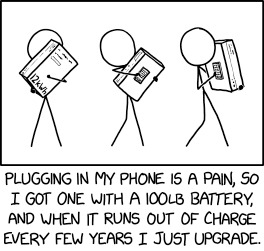Battery Life

It's okay, I'm at 10%, so I'm good for another month or two.

It's okay, I'm at 10%, so I'm good for another month or two.
Smartphones run on batteries that require frequent charging; they may also be frequently replaced with a newer model by their user, though battery life is only one of several reasons why they may do this. In this comic, instead of charging his phone every day for a few years and then buying a new phone, Cueball has obtained a phone with a battery big enough to last supposedly until the phone will be replaced after a few years. This appears to make for a phone of cumbersome weight and size. According to the caption, 10% of battery life corresponds to 1–2 months; this suggests a total battery life and hence product life of 10–20 months, which is less than two years. A 'few' is generally more than that, even in the world of xkcd. (This assumes that he'd be 'good' right up until 0%. He could be just talking about being generally unconcerned until it reaches 5%, say, from which point he knows he'll have a similar further amount of time to start seriously thinking about arranging the full replacement, and all that this entails.) More practically, a smartphone requires around 2 kWh per year (assuming this is not otherwise an untypical phone in terms of power requirements), so this 12 kWh battery could have been expected to last even longer.
A 12 kWh battery weighing 100 pounds (45 kg) has an energy density of 264.6 Wh/kg, about equal to the high-estimate of the energy density of lithium-ion batteries of 100–265 Wh/kg. However, it is well below the practically achievable energy densities of (non-rechargeable, as befits the application) zinc-air batteries at around 400 Wh/kg. Unfortunately, Self-discharge means that if this battery is lithium polymer, it will lose on average 5% of its charge per month, which totals to 46% lost each year. If this were a non-rechargeable battery such as lithium metal, its battery life could be much longer.
This comic appeared on the same day that the European Union standardized charging adapters for mobile phones.
This may be a commentary on very large external portable charging devices. At present (October, 2022) the largest cell-phone sized charging devices hold almost 40000mAh and can weigh almost a pound. Even larger devices are available weighing over 40 lbs in different form factors. We buy cell phones because of their small size and convenience,[citation needed] and end up buying extra external battery power for them that adds significant extra weight and bulk.
Portable (on wheels) 12 kWh lithium-ion batteries do exist but typically weigh over 250 lbs and tend to lack ports to plug a phone directly into. Roughly 100 lb portable power stations can have capacities as high as 6 kWh and can be used to charge a typical smartphone directly hundreds of times.